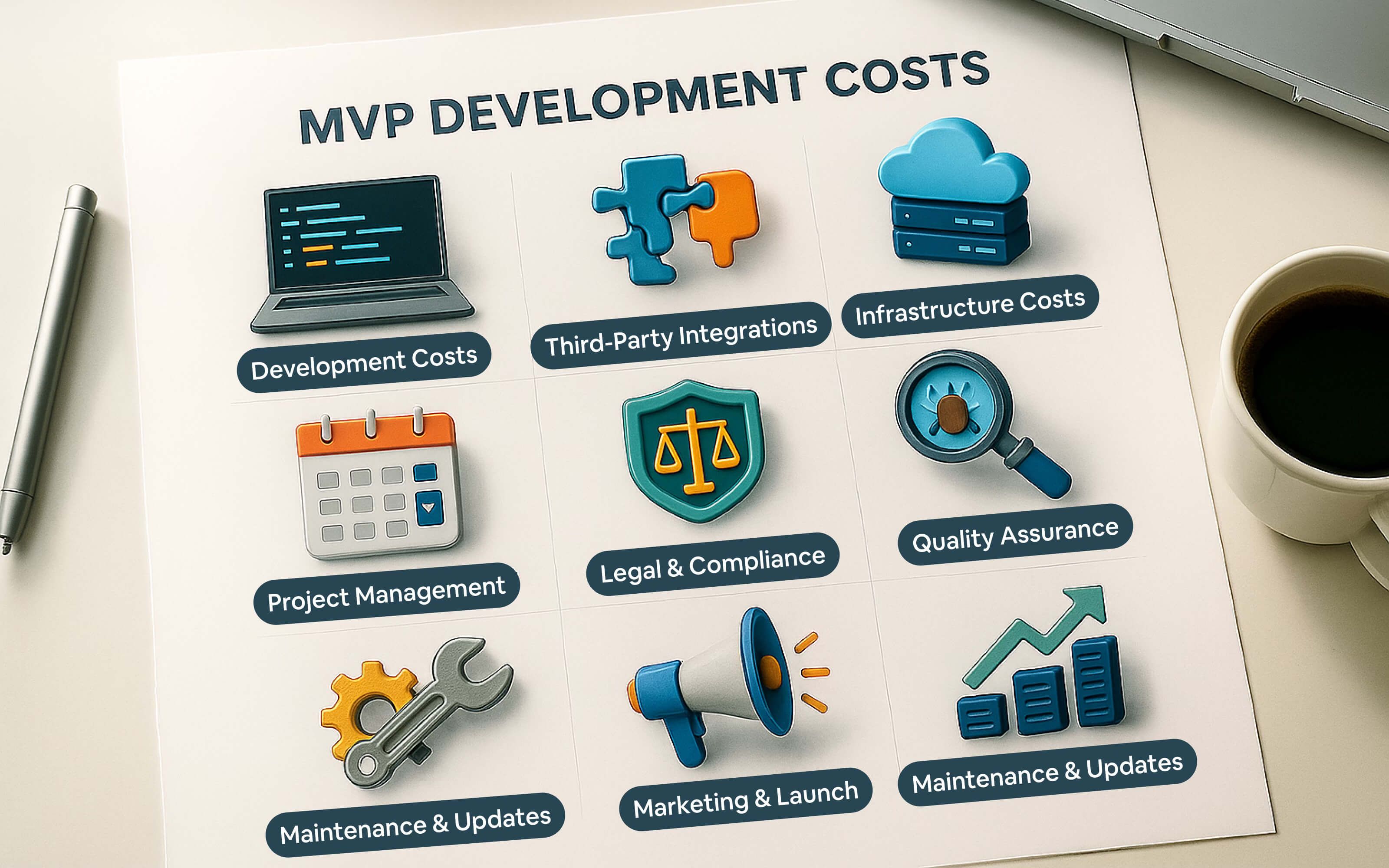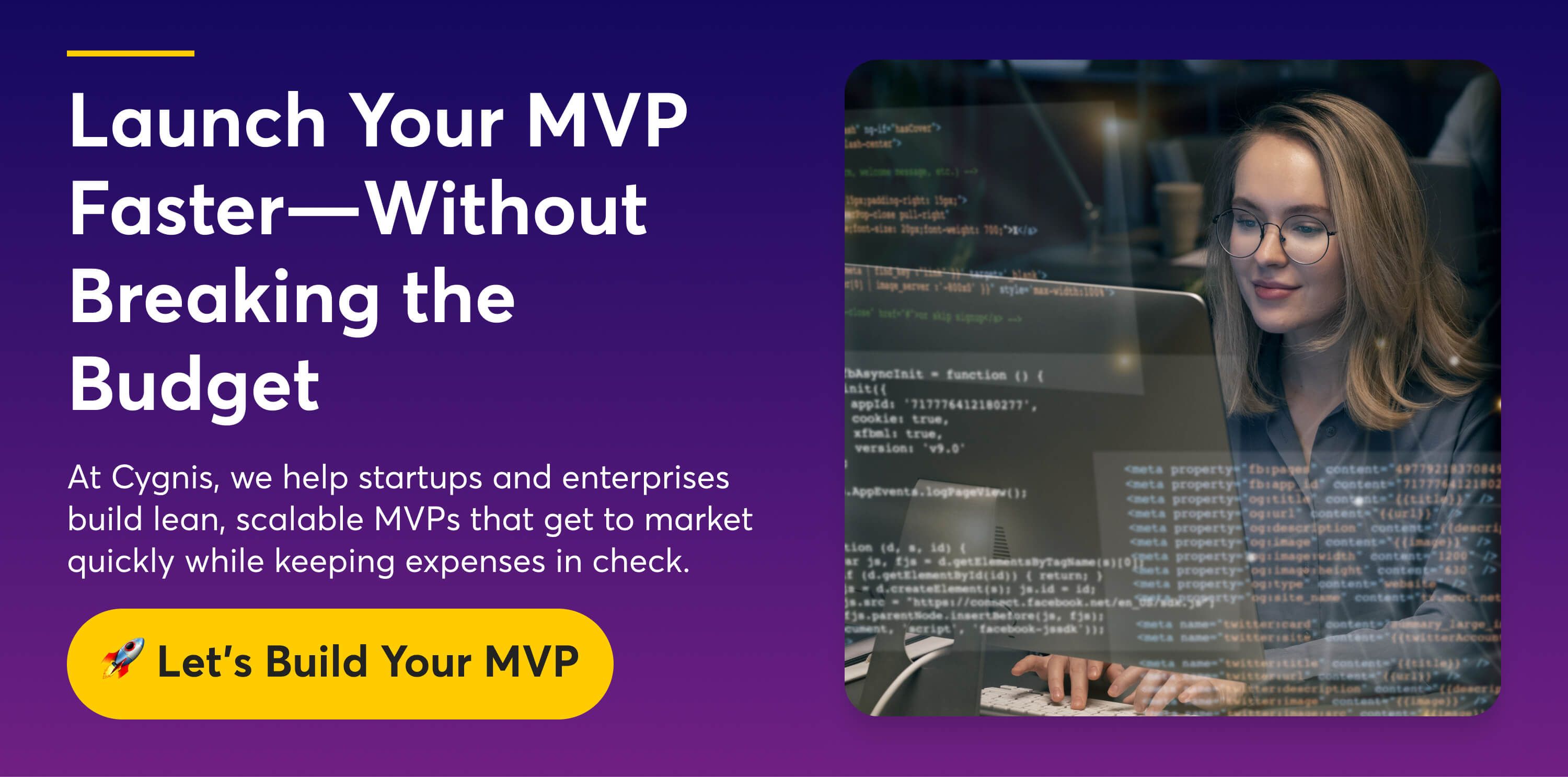Bringing a product to market quickly without incurring significant costs is a common challenge in Minimum Viable Product (MVP) development. Launching fast helps you gather real-world feedback and validate your idea early, but without careful planning and budgeting, it can increase expenses or compromise product quality.
The key lies in finding a balance—delivering a functional MVP that meets user needs without overspending or missing market opportunities. In this blog, we’ll explore how to balance your MVP development cost with speed. What factors influence your decisions, and what practical strategies help you find the sweet spot between staying lean and bringing your product to market quickly within your available resources and budget?
Let’s dive into exploring!
Key Takeaways
- A clearly defined budget helps prioritize core features, allocate resources effectively, and prevent overspending on unnecessary elements. Without proper budgeting, even small MVPs can escalate in cost and complexity.
- Launching your MVP early allows you to gather real user feedback, validate ideas, and make informed decisions before investing heavily in additional features or enhancements.
- Adding unnecessary or “nice-to-have” features increases development time, complicates testing, and drives up costs, diverting focus from the core user problem.
- Selecting the right tech stack—native, cross-platform, or low-code/no-code—affects development timelines, team requirements, and long-term scalability.
- Understanding your target users and choosing the right platform (web, mobile, or both) helps balance feature needs, costs, and development speed.
What is a Minimum Viable Product (MVP)

An MVP (Minimum Viable Product) is the first basic version of a product that includes just enough features to solve a core user problem and gather feedback. It’s built to test an idea quickly and cost-effectively before investing up-front in full-scale product development.
Key Aspects of an MVP
- Core Functionality Only: Focuses on the main problem your product aims to solve—only core features.
- User-Centric: Built with the end-user in mind to gather real feedback and validate interest.
- Quick to Launch: Developed in a short time to reach the market faster.
- Cost-Effective: Saves money by avoiding unnecessary features and keeping the scope lean.
- Test and Learn: Helps validate product-market fit and guide future improvements.
- Iterative by Nature: Designed to evolve based on user feedback and usage data.
- Low Risk: Limits financial and technical risk by testing early assumptions.
Learn more: How to Build a Minimum Viable Product (MVP)
Why Speed Matters in MVP Development

Speed is crucial in MVP development because it allows you to test your idea, gather user feedback, and iterate before investing heavily. Companies like Dropbox, Airbnb, and Uber launched a simple MVP early to validate demand, which helped them refine their product quickly and capture market interest ahead of competitors.
1. Quick Validation of Ideas
Faster time to market allows you to test your core concept with real users and determine if it solves their problem. This prevents you from spending your cost on building features that may not be needed.
2. Faster Feedback Loop
The earlier you launch, the sooner you can collect valuable feedback. This feedback helps you make informed decisions about which features to improve, add, or remove entirely.
3. Efficient Use of Resources
A quick launch reduces the risk of over-investing in unnecessary development. Instead of building a full-featured product upfront, you focus on what’s essential, saving both time and money.
4. Early Traction and Investment Opportunities
The faster you get your MVP in users’ hands, the sooner you can build a user base, generate traction, and attract potential investors or partners.
5. Competitive Advantage
Launching faster than competitors allows you to capture market share, establish brand recognition, and build customer loyalty before similar solutions emerge.
Why Budgeting is Crucial in MVP Development

Underestimating your MVP development cost can put your project at risk of stalling, while overspending early ties up resources before you know if your idea truly meets market needs. Therefore, creating a well-planned budget helps avoid hidden costs and supports sustainable scaling. Here’s why budgeting is essential from the start.
1. Defines Project Scope
Budgeting clarifies which features are essential for the MVP, preventing unnecessary work and keeping the project focused.
2. Supports Resource Allocation
A clear budget guides team roles, outsourcing, and tool investments, ensuring resources target high-priority MVP features efficiently.
3. Manages Hidden and Post-Launch Costs
Planning for maintenance, integrations, and updates prevents unexpected expenses that could arise during or after the MVP launch.
4. Builds Stakeholder Confidence
Transparent budgeting shows investors and teams that resources are thoughtfully allocated and that the MVP development is financially responsible.
5. Reduces Risk of Delays
Realistic budgeting ensures features are developed within planned timelines, avoiding stalled development and rushed compromises mid-project.
6. Ensures Efficient Use of Funds
Budget planning helps prioritize essential features, allocate capital wisely, and avoid wasting money on non-critical aspects of the MVP.
Costs to Consider in MVP Development

When developing an MVP, it's important to account for all potential costs to avoid unexpected expenses later. These expenses extend beyond development and include user-centric design, integration, testing, and ongoing maintenance. Understanding these cost categories helps you plan a realistic budget. Proper planning is essential for a smoother development process and a successful product launch.
| Cost Category | Description |
|---|---|
| Development Costs | This includes writing code, building features, designing UI/UX, fixing bugs, and creating technical documentation. |
| Third-Party Integrations | Charges for integrating external APIs, payment gateways, analytics tools, or other third-party services that improve functionality but come with usage or subscription costs. |
| Infrastructure Costs | Costs associated with hosting the MVP, including cloud servers, databases, content delivery networks (CDNs), and bandwidth. These costs can grow as user traffic increases. |
| Quality Assurance | Investment in both manual and automated testing processes to identify bugs, performance issues, and usability problems. QA ensures a stable and reliable product experience for users. |
| Project Management | Resources spent on coordinating the team, managing timelines, facilitating communication, and ensuring the project stays on track and aligned with business goals. |
| Legal and Compliance | Costs for drafting privacy policies, terms of service, and ensuring compliance with regulations like GDPR or HIPAA. This is crucial to avoid legal risks and build user trust. |
| Marketing and Launch | Budget for promoting the MVP, including digital marketing campaigns, user onboarding, and initial user acquisition to validate product-market fit. |
| Maintenance and Updates | Ongoing expenses post-launch for fixing bugs, improving performance, adding new features, and adapting to user feedback to keep the product competitive. |
| Scalability and Scaling | Costs involved in upgrading infrastructure, optimizing databases, and enhancing backend services as the user base grows to maintain performance and reliability. |
Factors that Affect MVP Development Cost and Speed
Balancing cost and speed in MVP development is rarely straightforward. Multiple factors influence how quickly you can launch and how much it will cost. From budget limitations to team structure, technology choices, and market demands, each decision impacts both timelines and expenses.
Understanding these factors helps you make informed decisions, ensuring your MVP delivers value efficiently without overspending or unnecessary delays. Here’s a breakdown of the key factors:
1. Budget Constraints
Your budget directly impacts what you can build, how fast, and with what resources. Startups often operate on lean budgets, while enterprises may invest more upfront. However, regardless of company size, overlooking hidden or future costs can quickly hinder development.
- Hidden Costs: These include ongoing maintenance, third-party service fees, API usage costs, and infrastructure scaling as user demand grows.
- Post-MVP Costs: Budgeting should extend beyond launch to cover iterations, user feedback implementation, bug fixes, scalability, and performance enhancements.
- Limited Funds: Limited funds can slow development if teams need to prioritize certain features or work in phases, delaying the final product.
- Balancing Quality and Cost: While cutting corners may reduce expenses in the short term, it can lead to higher costs later for fixing poor code quality, redesigning, or addressing technical debt.
2. Feature Complexity
The size, clarity, and technical demands of your MVP’s features directly influence development cost and timeline. Including unnecessary or “nice-to-have” features can increase workload, require additional development, and inflate budgets.
- Impact of Feature Volume – Adding too many features, especially non-essential ones, increases development, testing, and integration efforts, stretching timelines and raising costs.
- Effect of Ambiguous Requirements – Unclear or changing feature specifications lead to miscommunication, rework, and unplanned additions, further inflating time and budgets.
- Complexity and Skill Requirements – Highly technical or advanced features demand specialized expertise, which increases development costs and extends delivery timelines.
3. Scope Creep
Scope creep occurs when additional features or requirements are added during development, beyond the original plan. It can increase costs, extend timelines, and dilute the focus of your MVP.
- Increased Development Expenses – Adding unplanned features requires more developer hours, design work, and testing, directly raising the project’s overall cost.
- Extended Timelines – Each new requirement slows down progress, delaying launch and potentially increasing opportunity costs for market entry.
- Resource Strain – Expanding scope puts pressure on teams and tools, reducing efficiency and forcing reprioritization that may compromise essential features.
4. Technology Stack and Tools
The tools and technologies you choose set the foundation for development speed and scalability. While faster tech stacks can accelerate the development process, they may also introduce technical debt if not chosen wisely. Your decision should consider the project’s complexity, target platforms, team skills, and future scalability needs.
| Technology Option | Cost Considerations | Impact on Development Speed |
|---|---|---|
| Cross-platform frameworks | Generally more affordable since you develop once for multiple platforms | Enables quicker launches due to a shared codebase |
| Native mobile applications | Usually costlier upfront, with separate builds for each platform | Development takes longer due to platform-specific coding |
| Microservices & Serverless Architectures | Offers scalability but requires more investment in infrastructure and DevOps | Can speed up deployment with modular components, but has a steeper setup phase |
| Low-code/No-code solutions | Very cost-effective for simple MVPs but limited in customization | Extremely fast to deploy, ideal for basic prototypes |
According to Gartner, by 2025, approximately 70% of new applications will be built using low-code or no-code platforms—up from under 25% in 2020. This shift enables organizations to cut development costs and accelerate MVP launches.
5. Audience and Target Market
Understanding who your MVP is for plays a vital role in shaping both cost and development speed. Different target audiences have varying expectations, usage patterns, and feature demands, all of which impact your project’s complexity and timeline.
- User Expectations: Early adopters might tolerate a simpler, less polished product, allowing for a leaner MVP, while mainstream users often expect a more refined experience.
- Market Size: Targeting a niche audience might require fewer features and lower scalability, reducing costs and speeding up development. A broader market might need more robust features and infrastructure.
- Localization Needs: Serving multiple regions or languages adds development overhead and testing requirements, increasing cost and time.
6. Platform Selection: Web, Mobile, or Both
Selecting the right platform for your MVP greatly influences both cost and development time. Each choice comes with its own challenges in complexity and technical needs. It also affects how many users you can reach initially. Balancing these factors helps optimize your budget and launch schedule.
- Web-Only MVP: Developing a web app is usually faster and less expensive since it works across devices via browsers. However, it may lack some native device features and offline capabilities.
- Mobile-Only MVP: Building for iOS or Android offers access to device features and better performance but requires more time and budget, especially if targeting both platforms separately.
- Both Web and Mobile: Developing for both simultaneously increases costs and increases timelines, but maximizes user reach and flexibility, ideal for broad markets or complex products.
7. Scalability and Overhead Operational Cost
The ability of your MVP to handle growth and the ongoing operational expenses both have a direct impact on cost and development timelines. Planning for scalability often requires additional work upfront, while operational costs continue to accumulate after launch.
- Infrastructure Readiness – Building a system that can handle future user growth may require more robust servers, databases, and architecture, increasing initial development time and expenses.
- Performance Optimization Efforts – Ensuring smooth performance at scale can involve complex coding, load testing, and optimization, extending timelines, and requiring skilled resources.
- Ongoing Maintenance Costs – Regular updates, bug fixes, and technical support contribute to long-term operational expenses that can affect resource allocation.
- Third-Party Service Dependencies – Using external services like cloud hosting, analytics, or payment gateways can speed development initially but add recurring costs that need to be factored into long-term budgets.
Strategies to Optimize Both Cost and Speed to Maintain a Balance

Striking a balance between cost and speed is possible with the right strategies. You don’t have to sacrifice one to achieve the other. By setting clear priorities, choosing the right tools, and working smarter, you can build an MVP that delivers value quickly without draining your budget. Below are proven tactics to help you speed up development while keeping costs in check.
1. Define a Clear MVP Scope
In MVP development, scope defines what the initial product will include, setting clear limits on features and functionality. A well-defined scope keeps the team focused on the core problem. Avoiding scope creep ensures faster development, controlled costs, and timely delivery.
Determining the scope early helps:
- Allocate resources effectively across teams
- Keep the MVP focused on solving the core problem
- Reduce development time by avoiding unnecessary work
- Minimize risk of overspending on non-essential features
- Ensure clearer communication and alignment within the team
2. Prioritize Core Features
In MVP development, focus on essential features that deliver immediate value. This approach speeds up development and avoids unnecessary costs on non-essential features.
With prioritization tools, you can separate must-have features from nice-to-haves and build faster with purpose. Instead of trying to create your ideal product from the start, ask:
- Which features are essential to solve the core user problem?
- What can we leave out for the initial MVP to test the idea quickly?
Use a prioritization framework like MoSCoW (Must Have, Should Have, Could Have, Won’t Have) to decide what feature to build first.
- Must Have: Critical features the MVP cannot function without.
- Should Have: Important features that add value but aren’t essential for launch.
- Could Have: Nice-to-have features that can be added later if time and budget allow.
- Won’t Have: Features that are out of scope for the current MVP version.
3. Leverage Cost-Effective Tools
Choosing the right tools and platforms can significantly reduce both development time and costs. By leveraging affordable, efficient, and familiar solutions, you can deliver your MVP faster without sacrificing core functionality.
- Use frameworks and libraries that reduce development effort.
- Consider low-code or no-code platforms for simpler MVPs.
- Opt for open-source tools to minimize licensing fees.
- Evaluate third-party services for cost-effectiveness before integration.
- Select tools your team is already familiar with to avoid extra training time.
4. Build Iteratively (Agile Approach)
Adopting Agile methodology in MVP ensures you’re not building everything at once. Instead, development happens in smaller sprints, allowing regular testing and feedback. This iterative process minimizes risk, improves flexibility, and helps deliver value faster without massive upfront investments.
- Break the MVP into smaller, testable chunks (sprints).
- Continuous integration and feedback reduce rework and surprises.
- Flexibility to pivot based on feedback without heavy cost implications.
- Prioritize features in each sprint to focus on delivering immediate value.
- Track progress and adjust timelines to stay aligned with budget and goals.
5. Validate Early and Often
Waiting until the end to test and validate your ideas leads to wasted effort. Instead, validate throughout the development cycle. Engaging users with interviews, clickable prototypes, or wireframes saves time and money by identifying what's valuable before you build it. For this, you need to:
- Run user interviews, usability tests, or surveys during development.
- Use prototypes and wireframes before writing full code.
- Reduces time and cost spent on unwanted features.
- Gather continuous user feedback to refine features early.
- Incorporate insights quickly to prevent costly redesigns later.
6. Reuse Existing APIs and Integrations
Don't build everything from scratch—use third-party APIs for common features like payments or authentication. They save weeks of development time and come with the added benefit of being tested and maintained by industry leaders. Reusing existing APIs in your MVP development helps you:
- Save development time and cost by leveraging pre-built functionality.
- Reduce overall MVP development costs by avoiding building features from scratch.
- Ensure reliability through tested and proven solutions.
- Accelerate MVP launch by focusing on core product features.
7. Choose the Right Development Partners
Experienced MVP development teams can fast-track delivery without compromising quality. They understand lean practices and can guide you in making pragmatic choices. A good partner ensures strong communication, rapid iteration, and aligned expectations.
- Work with experienced MVP development teams who understand lean startup principles.
- Avoid over-engineering and focus on delivering a usable product quickly.
- Ensure clear communication and aligned expectations.
- Leverage their expertise to make pragmatic technology and feature decisions, optimizing both cost and delivery speed.
8. Start with a Clickable Prototype or PoC
Before writing any code, create a clickable prototype or a proof of concept. It’s an inexpensive way to communicate your vision, gather feedback, and secure stakeholder buy-in. These tools help refine ideas early—saving time during actual development.
- Use tools like Figma, InVision, or Marvel to demo your idea.
- Helps stakeholders and investors visualize the product before committing to full development.
- Great for refining the idea without writing code.
Learn more about: Poc vs. Prototype vs. MVP
9. Integrate Analytics & Set Clear KPIs
Collecting data and feedback from the start helps you make informed decisions, prioritize features effectively, and avoid investing in unnecessary changes mid-project. Early insights guide the team, reducing costly mistakes and accelerating iterations.
- Set up analytics tools to monitor user behavior and engagement from launch.
- Define KPIs aligned with core business goals and user outcomes.
- Gather feedback through surveys, interviews, or in-app prompts to understand user needs.
- Use insights to prioritize features and adjustments, reducing wasted development effort.
- Rapidly iterate based on real data, speeding up product-market fit and avoiding expensive rework.
Tips: From Idea to Reality: 10 Tips for MVP App Development
Additional Factors to Consider When Budgeting for Your MVP
1. Plan for Scalability
Building an MVP isn’t just about launching; it’s about laying a foundation that can grow with your user base and evolving product needs:
- Design your architecture to handle future feature expansions.
- Choose technologies that support higher traffic and larger data loads.
- Plan resource allocation to adapt to increasing demand.
- Keep scalability in mind to avoid expensive rework later.
2. Set Flexibility Within Budget
A rigid budget can limit your ability to iterate and respond to user feedback. Including flexibility ensures your MVP can adapt without derailing costs or timelines:
- Reserve 10–15% for unexpected needs.
- Plan for adjustments based on user feedback.
- Allow a buffer for potential pivots or technical fixes.
- Keep non-core features optional until validated.
3. Factor in Post-Launch Support
Costs don’t stop at launch; maintenance and updates are essential to retain users and keep the product competitive:
- Budget for bug fixes and minor feature enhancements.
- Allocate resources for customer support and monitoring.
- Plan for periodic performance optimizations.
- Include costs for iterative testing and continuous improvement.
4. Account for Compliance and Security
Ignoring legal, privacy, or security requirements can lead to costly penalties and redesigns:
- Include expenses for regulatory compliance like GDPR or HIPAA.
- Budget for security audits and data protection measures.
- Plan for secure user authentication and encryption protocols.
- Factor in legal consultation costs for terms of service and privacy policies.
Conclusion
When planning your MVP budget and scaling your team, it’s crucial to prioritize the product’s core value and define clear, achievable objectives. Aligning resources with the MVP’s scope ensures you avoid unnecessary spending on features that don’t validate your concept. This disciplined approach allows your team to remain agile, respond to real user feedback, and make informed, data-driven decisions.
Focusing on essential functionality enables you to reduce development time, control costs, and minimize technical debt. A well-planned budget and clear scope also make it easier to scale effectively as your product grows. Ultimately, this strategy ensures both time and money are invested wisely, supporting a sustainable path to product-market fit.











